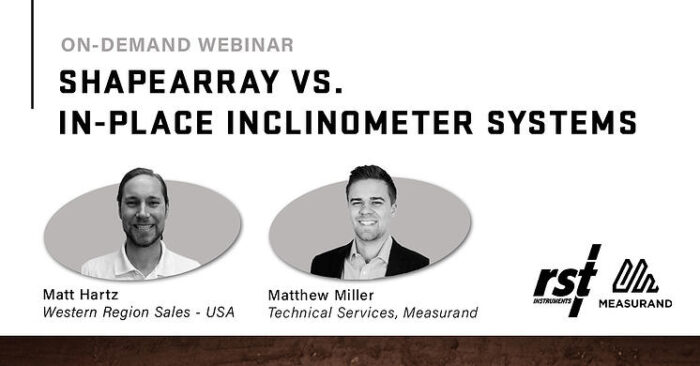Posts by Category
Recent Posts
- Leveraging ShapeArray for wireless automated remote deformation monitoring
- United under Orica Digital Solutions, Terra Insights and GroundProbe merge geotechnical technologies and capabilities
- Terra Insights joins Orica, expanding digital solutions platform
- Wide-area linear infrastructure monitoring with InSAR and Instrumentation: Your questions answered
- How to improve blasting practices in mining operations with vibration and air pressure monitoring: Your questions answered
- ShapeArray Fundamentals in 2023: Your questions answered
Vertical and horizontal deformation measurements provide invaluable information to engineers and decision-makers, but with different types of inclinometer systems and advances in remote automated data collection, there are many factors to consider when determining which geotechnical instrument is right for your specific project’s monitoring requirements.
RST Instruments’ Matt Hartz and Measurand’s Matthew Miller presented a live webinar that offered an in-depth analysis and comparison between ShapeArrayTM and in-place inclinometer (IPI) systems.
You can watch the on-demand version of the webinar here.

Does altitude affect ShapeArray calibration?
No. Altitude variations could cause slight differences in the readings; however, ShapeArray systems are designed to autocorrect the readings in those situations.
When is it better to monitor for larger trends instead of precision? Which system works best for these objectives?
The technical specifications for both systems are relatively close, so you can expect similar behaviour when the equipment is installed with the same spatial resolution. (e.g., sensors every 50 cm).
However, if we make a comparison between the equipment at different spatial resolutions, that is, with ShapeArray sensors every 50 cm and IPI sensors every 1 m or higher, higher reading accuracy can be expected from the equipment with higher spatial resolution. On the other hand, even with a lower spatial resolution (i.e., greater spacing between sensors), IPI continues to show good results with adequate trend monitoring.
In general terms, it is important to take the following aspects into account when choosing a deformation monitoring system:
- The technical specifications of your equipment
- The system’s spatial resolution
Does the deepest ShapeArray sensor need to be placed in competent rock or foundation?
Yes, the deepest ShapeArray sensor must be placed in a competent foundation or a position where no movement has been previously identified (e.g., with existing inclinometer tubes from previous surveys). It is also important to highlight that ShapeArray measures relative displacement, so it is essential to have an initial reference point with no displacement.
What power source does ShapeArray use?
A ShapeArray in regular power mode typically requires a 12 V power source and about 1.8 mA of current per segment when connected to Campbell Scientific data loggers or sensemetrics’ Thread. In low power mode, typically used with wireless loggers, ShapeArray uses an 8 V power source and 0.4 mA per segment.
In summary, the power source for a single ShapeArray usually takes one of two forms:
- Stationary batteries supplying the minimum 12 V and a current of 1.8 mA per segment.
- Lithium batteries in cases where wireless data loggers such as DTSAA, Loadsensing, or Ackcio are used.
You can find more technical details for each solution here.
How would ShapeArray be used and installed to monitor bridges?
For structural monitoring, ShapeArray is inserted into a tube with an inner diameter of 27 mm and fixed to the frame (usually with U-clamps near the equipment joints).
For bridge monitoring, ShapeArray can be installed vertically, horizontally, or even diagonally (at ±60° vertical and ±30° horizontal).
The equipment may be embedded in the piles of a bridge or, in the case of an existing structure, fixed on the outside. However, it is important to remember that ShapeArrays are relative-displacement monitoring equipment, so all their monitoring takes place in relation to a reference point that must be fixed or monitored externally with geodesic monitoring.
For sensors with separation greater than 5 m and wells 200 m deep, which system is most recommended?
For a case with a spatial resolution greater than 1.5 or 2 m, the recommended equipment would be an IPI system, since ShapeArray has a standard sensor spacing of 0.5 m for vertical applications and 1 m for horizontal applications. The maximum spacing between IPI sensors on the market is 3 m.
On the other hand, if you are looking for a higher spatial resolution over the entire 200 m length, ShapeArray might be a better option due to its simple installation and low cost.
How do different shapes of inclinometer casing affect the data?
Different inclinometer casing shapes do not necessarily affect the quality of readings. However, the installation might require more care, since common practice and support documentation essentially focus on standard inclinometer tubes.
That is, it is possible to use pipes with other cross-sections (e.g., hollow square steel tubes), but if the installation methodology is not properly adjusted, we can obtain results below the expected accuracy.
Speak with an Expert
I’m very happy with the quality of the instrumentation and technical support from RST, as always. They worked with us from the initial stages of the project to ensure that we were fully prepared and equipped to use the RSTAR network for the first time. They delivered everything within the tight project time frame to ensure that there were no delays on site, and the submersible tilt meters looked like new even after over twelve months of being submerged in Thames water!
-Richard Lipscombe, BEng (Hons), Director & Principle Consultant - RL Geotechnical Ltd
Related Posts
Leveraging ShapeArray for wireless automated remote deformation monitoring
Wireless automated remote deformation monitoring is transforming how engineers collect dat...
Wide-area linear infrastructure monitoring with InSAR and Instrumentation: Your questions answered
Terra Insights' Savanna Herman and 3vG's Murray Down presented Wide-area linear infrastruc...
ShapeArray Fundamentals in 2023: Your questions answered
Measurand’s Mitchell Pollock and Terra Insights’ Josh Smith presented ShapeArray™ Fu...






